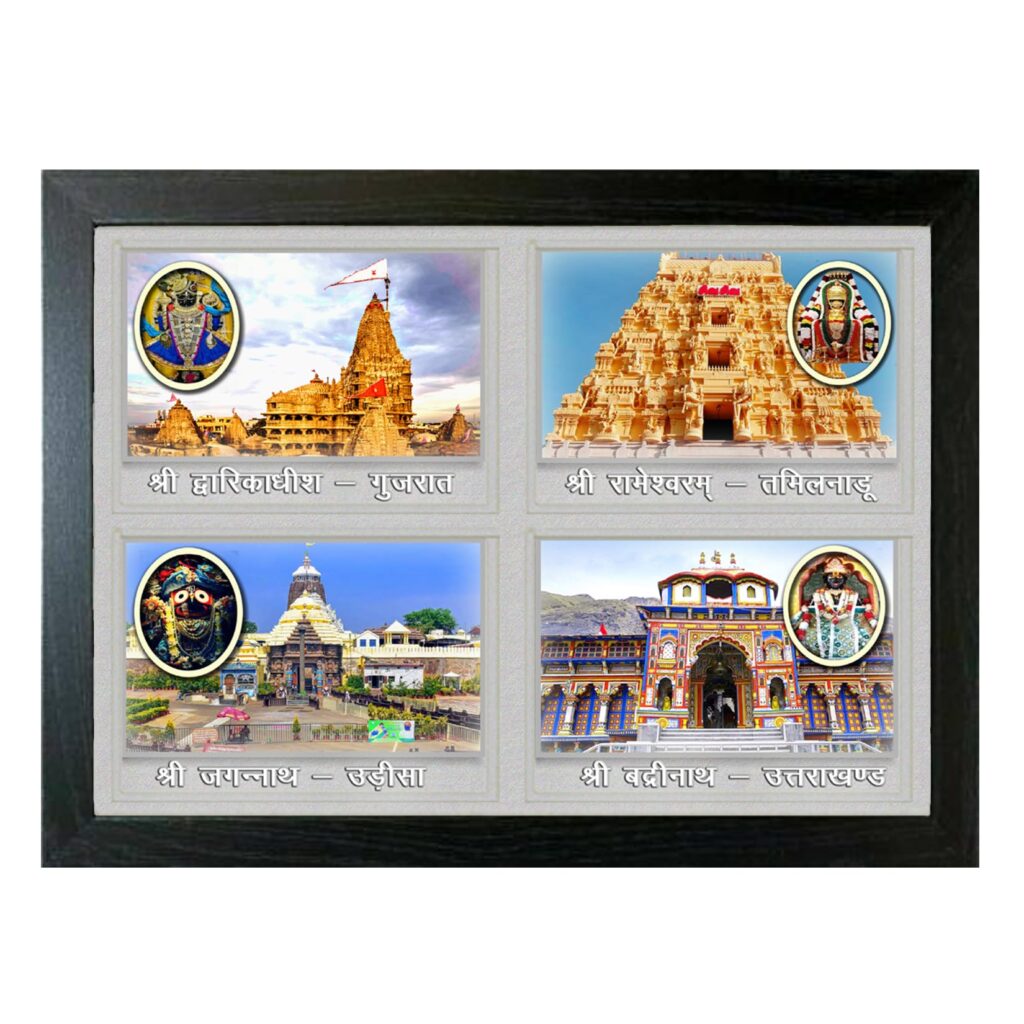Char Dham (Four famous pilgrimage sites in India)
1. Puri Jagannath Dham
Sri Jagannath temple is located in Puri, Odisha, is dedicated to “Sri Jagannath Mahaprabhu”, a form of “Vishnu”. On 10th century this temple construction was begun by the “king Ananta Varman ChodaGanga Deva”. This is considered as one of the “Char Dham”.
At this temple the “Trio” of deities “Jagannath”, “Balaram”, “Subhadra” are worshiped. In the inner sanctum of this temple these three Gods carved from sacred neem logs (known as “Daru sitting”) on the “Ratnabedi” are found with the statues of “Sudarshan Chakra”, “Madan Mohan”, “Sridevi” and “Vishwadhatri”. Here Lord Jagannath Dev was originally worshiped as “Nil Madhava”.
Here unlike other temples the presiding image of Lord Jagannath is made of Wood, which is ceremoniously replaced every twelve years by an exact replica (known as “Nabakalebar”). It is believed in spite of the idol being without hands it can watch over the world and be its Lord.
This is a sacred Hindu temple for “Vaishnava” Tradition. This temple is very significant for “Gaudiya Vaishnavism” as “Chaitanya Mahaprabhu”, was attracted by the deity and lived here for many years. Here “Rath Yatra” festival is celebrated every year.
This is most magnificent temple of India made in odia culture with 120 temple and shrines. The temple complex is 400000 sq ft area surrounded by “Meghananda Pacheri” (20 ft high wall). There are four distinct structures namely, “Garbha Griha”, “Mukhashala”, “Nat mandir” and “Bhog Mandapa”. The “Nil Chakra” (known as “Patita Pavan”) and a Flag (replaced everyday) are placed at the top shikhara of this temple.
2. Rameswaram Dham
Ramanathaswamy temple is located in Rameswaram Island of Tamil Nadu. It is considered as one of the “Char Dham”. It is known as one of the twelve “Jyotirlingas” and one of the “Paadal Petra Sthalam”. It is a holy pilgrimage site for “Shivaites”, “Vaishnavites”, and “Smarthas”.
It is believed that the presiding “Lingam” of “Lord Ramanathaswamy” was worshiped and established by “Rama” (Seventh avatar of God Vishnu) before crossing the bridge to Lanka.
Here are two Lingam, one was built by Rama with sand (Rama Lingam) and another brought by Hanuman from Kailash (Vishwa lingam).
There is a huge compound wall (865 ft in East-West and 657 ft North-South) on four side of temple premises. In India this temple has the longest outer corridor (6.9m height, 400 ft in East-West and 640 ft in North-south) among all Hindu temples.
Here the Junction of the third corridor and the paved way to “Setumadhaba Shrine” forms a unique structure in the form of a “Chess board” known as “Chokkatam Mandapam”, where the Utsav Deities are kept and worshiped during “Vasanthotsavam” (Spring festival).
3. Dwarka Dham:-
“Devbhoomi Dwarka” is located in the west of Gujarat, on the right bank of “Gomti” river. In Sanskrit “Dwar” means “Gate”. It is considered as one of the “Char Dham” and “Sapta Puri” (one of the most ancient seven pilgrimage cities). It was the ancient kingdom of “lord Krishna” after he defeated his uncle “Kansa” in “Mathura”.
This holy city is well known for its Temples. “Dwarkadheesh Temple” (also known as “Jagat Mandir”), Situated in the heart of this city. It is also known as “Dwarka Pith”, established by “Adi Shankaracharya” in the 8th century AD.
The layout of this temple consists of a “Garbhagriha” (Nijamandira) and an “Antarala”. The flag on the top of this temple shows sun and moon which indicates “Lord Krishna” will be there till Sun and Moon exists. Main deity of this sanctum is “Dwarkadheesh”, Trivikrama form of “Lord Vishnu”, with four arms.
“Gomti Ghat” is also a holy place consisting of small holy shrines of “Samudra”, “Saraswathi” & “Lakshmi”. Famous “Rukmini Devi” Temple is also situated in “Dwarka Dham”.
4. Badrinath Dham
Badrinath Dham is considered as one of the four “Chardham” in India. It is a holy city located in Uttarakhand. It gets its name from the famous “Badrinath temple”. According to Hinduism, it is one of the eighth “Swayam Byakta Kshetram” (self-manifested deities) of “Lord Vishnu”.
In 8th century “Adi Shankaracharya” reestablished “Badrinath” as a major Hindu pilgrimage site. People believed that, Shankar discovered a black stone image of “Lord Badrinarayana” made of “Shaligram” stone in the Alakananda river. Then he enshrined it originally in a cave near the “Tapt Kund” hot springs.
In 16th century King of Garhwal moved the shrine to the present temple. This 50 ft tall temple has a “Garbhagriha” where “Badrinarayana” is sitting in “Padmasana” posture.
People used to walk hundreds of miles to visit “Badrinath temple”. It is a sacred pilgrimage site for “Vaishnavites”. In Hindu scriptures Badrinath is referred as “Badrikashram”. It is a place sacred to “Lord Vishnu’s” dual form “Nara-Narayana”. “Badri – Kedar” festival is celebrated in the month of June in this temple.


